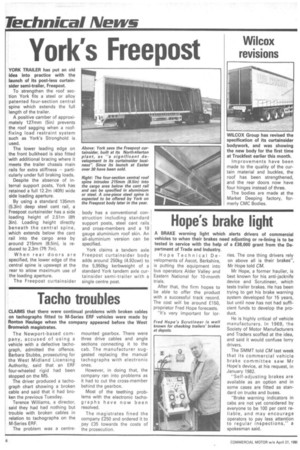Hope's brake light
Page 18

If you've noticed an error in this article please click here to report it so we can fix it.
A BRAKE warning light which alerts drivers of commercial vehicles to when their brakes need adjusting or re-lining is to be tested in service with the help of a 08,000 grant from the Department of Trade and Industry.
Hope Technical Developments of Ascot, Berkshire, is putting the equipment into bus operators Alder Valley and Eastern National for 10-month trials_ After that, the firm hopes to be able to offer the product with a successful track record. The cost will be around £150, proprietor Fred Hope forecasts.
'It's very important for lor ries. The one thing drivers rely on above all is their brakes", Mr Hope told CM.
Mr Hope, a former haulier, is best known for his anti-jacknife device and Scrutineer, which tests trailer brakes. He has been trying to get his brake warning system developed for 15 years, but until now has not had sufficient funds to develop the product.
He is highly critical of vehicle manufacturers. In 1969, the Society of Motor Manufacturers and Traders scoffed at the idea, and said it would confuse lorry drivers.
The SMMT told CM last week that its commercial vehicle brake committee saw Mr Hope's device, at his request, in January 1982.
"Self-adjusting brakes are available as an option and in some cases are fitted as standard on trucks and buses.
"Brake warning indicators in cabs are not yet considered by everyone to be 100 per cent reliable, and may encourage operators to pay less attention to regular inspections," a spokesman said.




































































































